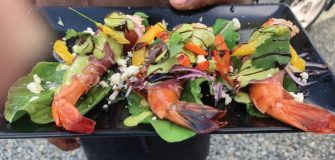Share
Ovoid to nearly heart-shaped, covered in knobby gray/ blue/green hues that look almost like scales on the outside, and sweet sections of glistening, creamy-white flesh on the inside with a shockingly pleasant aroma – this fruit I love dearly. It is known as the sugar apple in this neck of the woods (the British Virgin Islands).
Sugar apples (Annona squamosa) are the fruit of one of the most commonly grown Annona trees. The sugar apple tree varies in height from 10-20 feet with a
branching pattern of irregular, zigzagging twigs. The leaves are dull green on top and pale green on the underside while the flowers which may be single or in clusters are yellow-green with a pale yellow interior borne off of long drooping stalks.
The fruit of sugar apple trees is about 2½ to 4 inches long. Each fruit segment typically contains a ½-inch long black to dark brown seed, of which there may be up to 40 per sugar apple. Most sugar apples have green skins, but a dark red variety is attaining some popularity. Fruit ripens 3-4 months after flowering, and fruiting occurs several times a year in our climate.
Sugar Apple Uses
The fruit of the sugar apple tree is eaten by hand when ripe, separating the fleshy segments from the outer peel and spitting the seeds out. The pulp may also be pressed to eliminate the seeds. This pulp makes a tasty and refreshing beverage when added to ice cream, or combined with milk. Green (or unripen) sugar apples are boiled and eaten with a layer of mayonnaise or butter sauce, cornmeal dumplings and fish.
The seeds of the sugar apple are poisonous. The powdered seeds or dried fruit can be used as an insecticide. A seed paste can be made to treat lice and the oil derived from the seeds has also been used as a pesticide.
Sugar Apple Benefits
There are many benefits of the sugar apple. It has many vitamins and minerals such asprotein, zinc, and potassium. It is also heavy in folic acid, which is a highly important vitamin for pregnant women. Women trying to conceive are recommended to have folate as well, and sugar apples also benefit lactating
mothers by promoting milk production.
There are numerous other benefits such as dermatological benefits, asthma prevention, controlled cholesterol, healthy bones, and much more. It can even be used by menstruating women to replenish lost minerals.
Growing the Sugar Apple
The trees do well in a variety of soils, provided they have good drainage. When growing sugar apple trees, propagation is generally from seeds that may take 30 days or longer to germinate. To hasten germination, scarify the seeds or soak them for 3 days prior to sowing them in a plant pot. Wait until two days after germination before planting it directly in the soil.
At the time of transplanting, transplant your sugar apples seedlings in the soil late in the evening where they may get full sun, and 15-20 feet away from other trees or buildings.Feed young trees every 4-6 weeks during the growing season with a complete fertilizer such as 20-20-20. Apply a 2- to 4-inch layer of mulch
around the seedlings to within 6 inches of the trunk to retain moisture and regulate soil temperature.
Irrigation Practices (Watering)
Periodic watering of sugar apple seedlings is recommended from flowering through fruit development to enhance fruit quality and production. Over watering may lead to root rot and loss of tree vigor and health.
Pruning
Periodic pruning of sugar apple trees can easily maintain trees at or below 8 to 12 ft. (2.4-3.7 m) in height. To maintain optimum fruit production, trees should be selectively pruned annually. In general, about one third of the previous year’s vegetative growth should be removed during the rainy season as trees commence bud break. The goal is to maintain fruit production in the lower tree canopy, improve light penetration into the canopy, and limit tree size.
Insect Pests
Annona seed borer (Braephratiloides cubense): The annona seed borer (ASB) is the most dangerous insect pest of sugar apple in the British Virgin Islands. Female ASB lay their eggs in the young seeds of small fruits. The larva develops inside and the adult emerges, ruining the fruit in the process. Signs of insect
damage include small, black holes on the fruit surface, and brown to black decay of the fruit. Bagging individual fruit in small paper lunch bags will prevent the ASB from infesting fruit.
Plumose Scale (Morganella longispina): Plumose scale attacks the shoots and stems of sugar apple trees. Plumose scales are dark brown to grayish brown, circular, and often found infesting the crotch angle areas of stems and shoots. Damage from heavy infestation results in loss of tree vigor, leaf browning and
drop, and stem and shoot dieback. Philephedra Scale (Philephedra n.sp.): Philephedra scale attacks mature and immature leaves, leaf petioles, young stems,
and fruit. Most commonly, these scales are found on the undersides of leaves. Damage from heavy infestation results in loss of tree vigor, leaf browning and drop, and stem dieback.
Mealy Bugs (Pseudococcus sp.): Mealy bugs are generally found at the stem-end of the fruit and the shady side of the fruit. Mealy bugs are small, white scale insects with wispy protuberances along their surfaces. They exude a sticky, sugary substance, which becomes colonized by fungi, giving the fruit surface
(and sometimes adjacent leaves) a sooty appearance. This is referred to as “sooty mold”.
Diseases
Dry Fruit Rot: The dry fruit or mummification of the fruit is caused by several fungi. The fruit appear purplish-black to black and may remain on the tree for some time. Usually fruit are colonized by these fungi after emergence of the adult annona seed borer from the fruit. Fruit Rot: Fruit may be attacked by fungi which cause the fruit to rot before or after harvest. Fruit symptoms are very similar to dry fruit rot.



